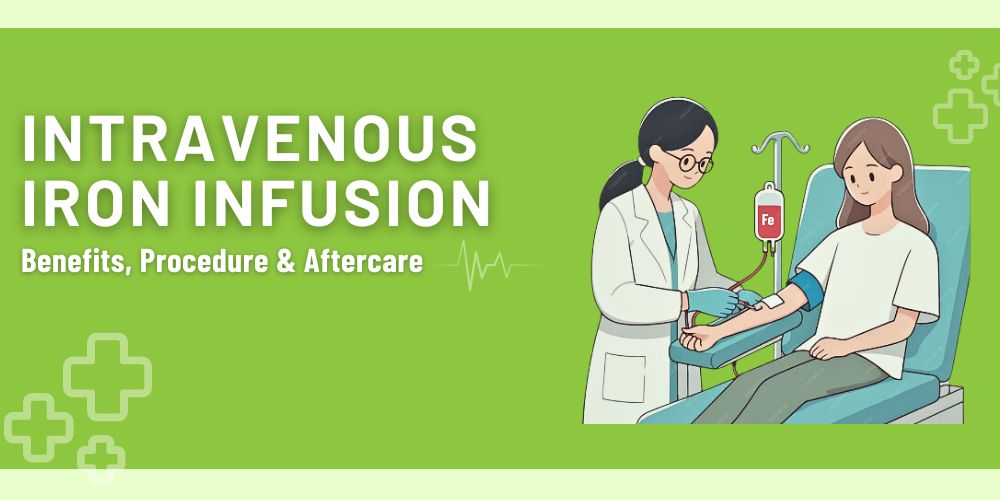Iron is a vital mineral that our body requires for various functions. One of its main roles is in the production of hemoglobin. Hemoglobin is responsible for transporting oxygen in our blood. Iron deficiency can lead to anemia, a condition characterized by fatigue, weakness, and other health issues.
While dietary changes and oral supplements are commonly used to manage iron deficiency, there are cases where intravenous (IV) infusion is the preferred treatment. This blog aims to provide an in-depth understanding of intravenous iron infusion, its benefits, procedures, and what patients can expect.
What is Intravenous Iron Infusion?
Intravenous iron infusion is a medical treatment used to deliver iron directly into the bloodstream through a vein. This method bypasses the digestive system, allowing for quicker and more efficient absorption of iron compared to oral supplements. IV iron infusion is often recommended for individuals who cannot tolerate oral iron, have chronic kidney disease, or suffer from severe iron deficiency anemia that does not respond well to oral iron therapy.
When is IV Iron Infusion Needed?
IV iron infusion is considered in the following scenarios:
- Severe Iron Deficiency Anemia: When oral iron supplements are insufficient or ineffective.
- Chronic Kidney Disease: Patients on dialysis often need IV iron because they lose blood often and have trouble absorbing iron.
- Gastrointestinal Disorders: Conditions like Crohn’s disease, celiac disease, or post-gastric bypass surgery can impair iron absorption, making IV iron a viable option.
- Cancer Patients: Those undergoing chemotherapy may experience anemia and require IV iron to manage their condition.
- Intolerance to Oral Iron: Some patients experience significant gastrointestinal side effects from oral iron supplements, such as nausea, constipation, or stomach pain, making IV iron a more tolerable alternative.
Types of IV Iron Preparations
Several types of IV preparations are available, each with different formulations and dosing schedules. Common types include:
- Iron Sucrose (Venofer): Often used for patients with chronic kidney disease. Administered in multiple doses over several sessions.
- Ferric Carboxymaltose (Injectafer): Typically given in two doses, spaced a week apart. Suitable for a quick increase in iron levels.
- Iron Dextran (INFeD, Dexferrum): Requires a test dose due to a higher risk of allergic reactions. Administered in larger single doses.
- Ferumoxytol (Feraheme): Used primarily in patients with chronic kidney disease. Can be administered quickly over a few minutes.
- Ferric Gluconate (Ferrlecit): Administered over several sessions, similar to iron sucrose.
The Procedure
Preparation:
– Consultation: The process begins with a thorough consultation with a healthcare provider to assess iron levels through blood tests and determine the need for IV iron.
– Allergy Testing: In some cases, especially with iron dextran, a test dose may be administered to check for allergic reactions.
During the Infusion:
– Setting: IV iron infusion is usually performed in a hospital, clinic, or specialized infusion center.
– Insertion: A healthcare professional will insert an intravenous line into a vein, typically in the arm.
– Administration: The iron solution is slowly infused into the bloodstream over a period ranging from 15 minutes to several hours, depending on the type and dose of iron.
– Monitoring: Vital signs are monitored throughout the procedure to ensure there are no adverse reactions.
Post-Infusion:
– Observation: Patients are often observed for a short period post-infusion to monitor for any delayed reactions.
– Follow-Up: Follow-up appointments and blood tests are scheduled to monitor iron levels and assess the effectiveness of the treatment.
Benefits of IV Iron Infusion
- Rapid Improvement: IV iron allows for a quicker correction of iron deficiency anemia compared to oral supplements.
- Higher Absorption: Bypassing the digestive system ensures that 100% of the administered iron is available for use by the body.
- Tolerability: IV iron is an excellent option for patients who experience gastrointestinal side effects from oral iron.
- Convenience: Fewer doses are needed to achieve desired iron levels, making it a convenient option for many patients.
Potential Risks and Side Effects
While IV iron infusion is generally safe, it is not without risks. Possible side effects include:
- Allergic Reactions: Mild to severe allergic reactions can occur, especially with iron dextran. Symptoms may include rash, itching, dizziness, or difficulty breathing.
- Gastrointestinal Symptoms: Although less common than with oral iron, some patients may experience nausea, vomiting, or stomach cramps.
- Headache and Dizziness: Some individuals may feel lightheaded or develop headaches during or after the infusion.
- Injection Site Reactions: Pain, swelling, or bruising at the injection site can occur.
- Hypotension: A drop in blood pressure may be observed, particularly if the infusion is administered too quickly.
Aftercare and Recovery
Post-infusion care is crucial to ensure the effectiveness of the treatment and to monitor for any delayed side effects. Patients are advised to:
- Stay Hydrated: Drinking plenty of fluids can help mitigate some side effects and aid in recovery.
- Avoid Strenuous Activities: Rest and avoid heavy physical activity for the remainder of the day following the infusion.
- Monitor for Symptoms: Keep an eye out for any signs of allergic reactions or other side effects and report them to your healthcare provider immediately.
- Follow-Up Appointments: Attend all scheduled follow-up appointments to monitor iron levels and adjust treatment as necessary.
Conclusion
Intravenous iron infusion is a valuable treatment for individuals with severe iron deficiency anemia or those who cannot tolerate oral iron supplements. It offers a rapid and effective means of restoring iron levels, with fewer side effects compared to oral treatments.
As with any medical procedure, it is essential to have a thorough consultation with a healthcare provider to determine the appropriateness of IV iron infusion for your specific condition. By understanding the process, benefits, and potential risks, patients can make informed decisions about their treatment and work towards improved health and well-being.
DR. EBRAHAM JATTA, NMD
Dr. Ebraham Jatta, NMD, is a dedicated licensed physician, certified by the Naturopathic Physician Medical Board of Arizona. With a wealth of clinical expertise in Holistic and Primary Care… Read More





